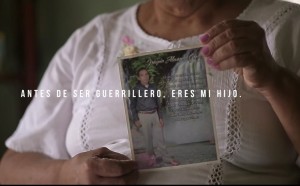Editor’s Note: I am pretty upset about the U.S. military’s mind-boggling bungling of information operations (IO) and strategic communications programs, particularly in Afghanistan and Iraq. Here’s a positive post on psychological operations in Colombia to break up what will be a series of critiques (I have another post planned on why lying, except in battle planning in the spirit of Sun Tzu, is counterproductive to stabilization and democratization). Also, on a full disclosure note, a previous employer/client of mine worked with the Colombian government to run outreach campaigns in Colombia on behalf of the U.S. Agency for International Development, so I am beyond thrilled peace may be in reach for the Colombian people.
 News coming out of Colombia during the holiday season warmed your heart. The end of Latin America’s longest insurgency may be in reach, and the government’s heart-warming Christmas campaigns targeting Revolutionary Armed Forces of Colombia guerrilla fighters (better known as the FARC) are a case study in how to do behavioral communications right.
News coming out of Colombia during the holiday season warmed your heart. The end of Latin America’s longest insurgency may be in reach, and the government’s heart-warming Christmas campaigns targeting Revolutionary Armed Forces of Colombia guerrilla fighters (better known as the FARC) are a case study in how to do behavioral communications right.
The award-winning Christmas campaigns, taking place the last four years, are strategically designed to motivate guerrilla fighters to sneak out of the jungle and surrender their weapons at the time of year they are the most homesick and vulnerable. Colombia’s Ministry of Defense, in conjunction with the Lowe SSP3 ad agency, runs the annual campaign, which mixes advertising with social marketing’s prompts, barriers elimination, and influencer messaging. Moreover, the positively framed ads and holiday light references elicit feelings of happiness around the prospect of defections and remembrance of religious values.
The campaigns get better and better every year:
- In 2010, when the campaign was first launched, government commandos put Christmas lights on giant trees deep in the heart of guerrilla territory with the message: “If Christmas can make it into the jungle, you can make it home.”
- In 2011, the family and friends of guerilla fighters were enlisted to put Christmas messages and small gifts in 7,000 LED-illuminated capsules sent floating down rivers guerrilla fighters frequent.
- In 2012—amid intelligence reports the FARC was moving troops around at Christmas to keep them disoriented and discourage defections—five powerful beacons of light were put up in town plazas near where the FARC operate and thousands of tiny lights were dropped along paths guerrilla fighters travel. Glow-in-the-dark billboards reading, “Guerrillas, Follow the Light,” were then put up along FARC river routes and glow-in-the-dark stickers were put on vehicles believed to be carrying them food.
- This year—with a cease fire in place giving guerrilla fighters more time to spend in town with access to TV and radio—posters and TV and radio ads were produced telling the real-life stories of about 30 mothers whose children are FARC members. The posters and TV ads show a real family picture of one of today’s guerilla fighters as an innocent child, with the mother’s message: “Before you were a guerrilla, you were my son.” Ads end with the line, “This Christmas, we’re waiting for you at home. Demobilize. At Christmas everything is possible.”
Here’s a YouTube video from this year’s campaign. You don’t even have to speak Spanish to be moved:
I could go on and on about how strategically sound the annual campaigns are in terms of conceptualization, design, implementation, and evaluation, but others, such as the World Economic Forum, have already done this. I love the way the World Economic Forum ended its evaluation piece last year:
“Wider societal impact was achieved: In addition to the direct effect on guerrillas, the campaigns also had a broader impact: to some degree they changed the context for the conflict, and improved international perceptions of the country.
Conclusions and Recommendations
The campaigns, and all of the accompanying press and social media coverage, have had a unique ‘humanizing’ effect which led to wider shifts in perception and behavior:
- The campaigns made guerrillas increasingly feel they are still part of society, even though they have chosen to stay on the fringes. They made them feel wanted and nostalgic;
- Crucially, the campaigns changed the military’s disposition to welcome the demobilized “enemy” by reminding them that these combatants are as human as they are after all; and,
- By touching the hearts of ordinary Colombians, the three operations helped smooth the reinsertion into society process by destroying some barriers that existed against accepting demobilized guerrillas in their workplaces or in their neighbourhoods.
The over-riding message is that even in the most challenging of circumstances, communication can be a powerful tool of behavior change.”
Surely, there had to be a way to design similarly effective behavioral campaigns in Afghanistan or Iraq respectfully eliciting the warm fuzzies via moderate Muslim traditions to achieve key objectives?